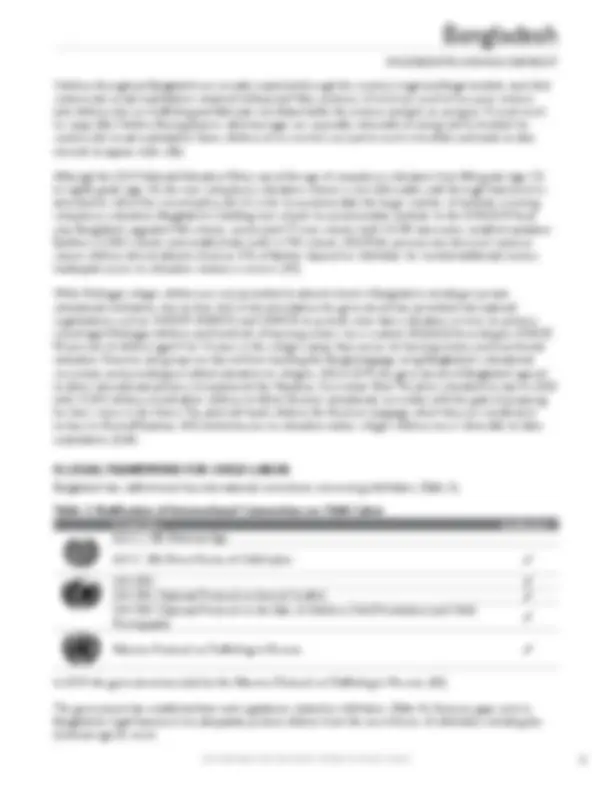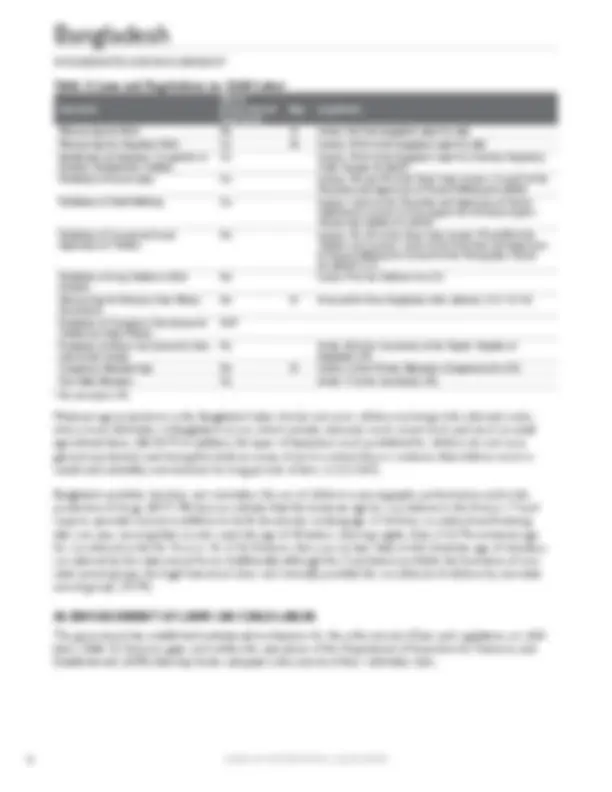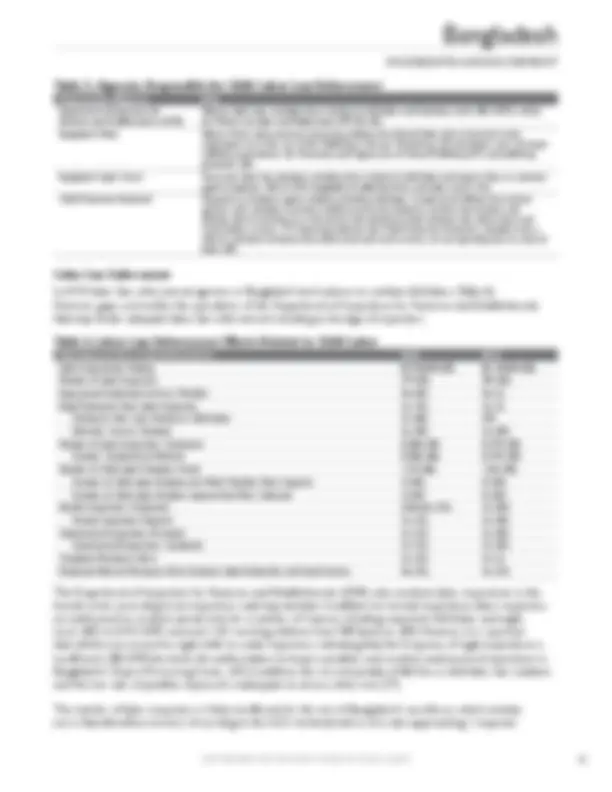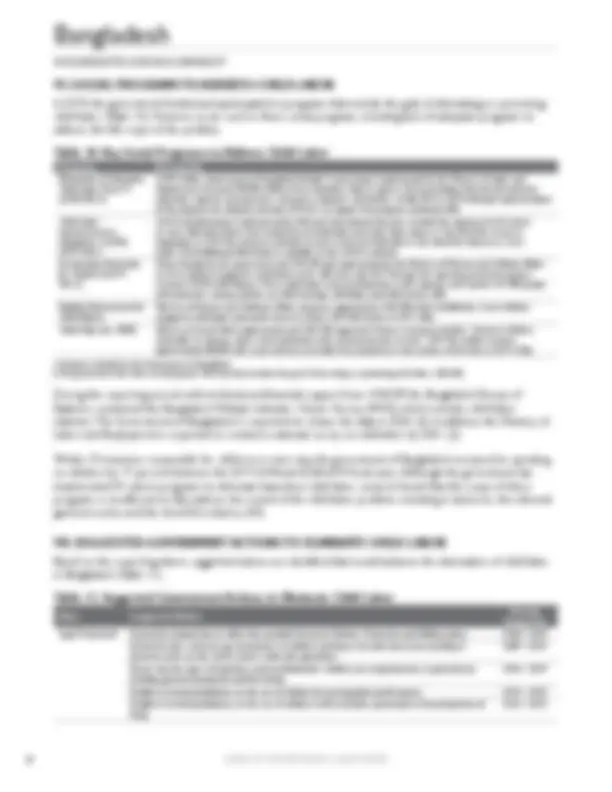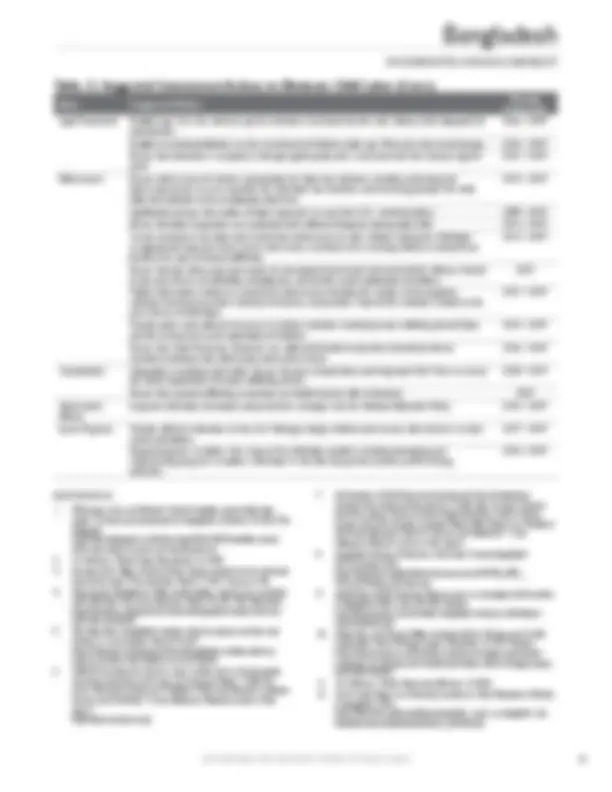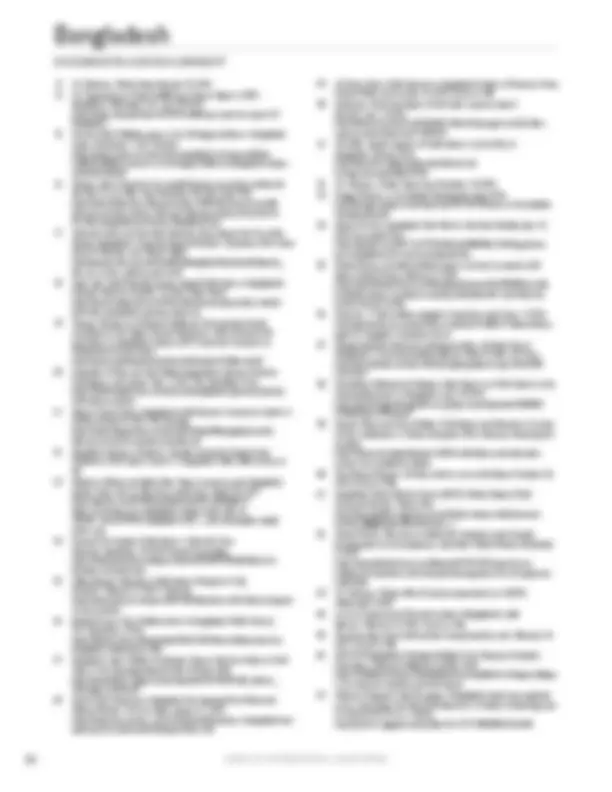Download 2019 Findings on the Worst Forms of Child Labor: Bangladesh and more Summaries Law in PDF only on Docsity!
MODERATE ADVANCEMENT
2019 FINDINGS ON THE WORST FORMS OF CHILD LABOR 1
In 2019, Bangladesh made a moderate advancement in
efforts to eliminate the worst forms of child labor.The
government acceded to the Palermo Protocol on Trafficking
in Persons and, through its programs in 2019, removed
over 1,000 working children from 558 factories, provided
education for 1,254 street children, and rehabilitated 3,
children. Since 2017, government programs have removed
90,000 children from hazardous labor conditions, and over
35,000 children from exploitative work.Within 15 ministries
responsible for children in some way, the government of
Bangladesh increased its spending on children by 17 percent
between the 2017-2018 and 2018-2019 fiscal years.
However, children in Bangladesh engage in the worst forms
of child labor, including forced child labor in the production of
dried fish and bricks. Children also perform dangerous tasks
in garment and leather goods supply chains. Moreover, the
Bangladesh Labor Act does not apply to the informal sector,
where most child labor in Bangladesh occurs, and hazardous
work prohibitions are not comprehensive. Additionally, labor
inspectors are not authorized to assess penalties and, when
courts do impose them, the fines are too low to deter child
labor law violations.
I. PREVALENCE AND SECTORAL DISTRIBUTION OF CHILD LABOR
Children in Bangladesh engage in the worst forms of child labor, including forced child labor in the production
of dried fish and bricks. (1,2) Children also perform dangerous tasks in the production of garments and leather
goods. (2-5) Table 1 provides key indicators on children’s work and education in Bangladesh.
Table 1. Statistics on Children’s Work and
Education
Children Age Percent
Working (% and population) 5 to 14 4.3 (1,326,411)
Attending School (%) 5 to 14 89.
Combining Work and School (%) 7 to 14 1.
Primary Completion Rate (%) N/A 67.
Source for primary completion rate: Data from 2010, published by UNESCO Institute for Statistics, 2020. (6)
Source for all other data: International Labor Organization’s analysis of statistics
from Labour Force Survey (LFS), 2013. (7)
Based on a review of available information, Table 2 provides an overview of children’s work by sector and activity.
Table 2. Overview of Children’s Work by Sector and Activity
Sector/Industry Activity
Agriculture Harvesting and processing crops, including tobacco, raising poultry, grazing cattle, and harvesting tea leaves (2,8-12)
Fishing and drying and processing fish (1,2,8,10,11,13-15)
Harvesting and processing shrimp (2,11)
Industry Producing garments, textiles, and jute textiles (16-22)
Producing leather,† leather goods, and footwear† (2,23-30)
Figure 1.Working Children by Sector, Ages 5-
Agriculture 39.7%
Services 30.9%
Industry 29.4%
MODERATE ADVANCEMENT
2 BUREAU OF INTERNATIONAL LABOR AFFAIRS
Sector/Industry Activity
Industry Manufacturing bricks,† glass,† hand-rolled cigarettes (bidis),† matches,† soap,† furniture (steel),† aluminum products,†
and metal products (2,8,11,31-35)
Ship breaking† and battery recycling† (2,29,36-38)
Construction† and breaking bricks† and stones† (8,10,11)
Services Domestic work (2,10,11,14,39-42)
Garbage sorting and recycling (43)
Working in transportation, including ticket tacking, welding, pulling rickshaws, driving, and repairing
automobiles† (2,8,10,14,25,42-45)
Working in tea shops and retail shops (8,10,14)
Categorical Worst
Forms of Child
Labor‡
Use in illicit activities, including smuggling and selling drugs (2,11,46,47)
Forced begging (2,14,46)
Forced labor in the drying of fish and the production of bricks (1,2,13-15)
Commercial sexual exploitation, sometimes as a result of human trafficking (2,14,48-51)
Forced domestic work, sometimes as a result of human trafficking (2,10,11,14,46,52,53)
† Determined by national law or regulation as hazardous and, as such, relevant to Article 3(d) of ILO C. 182. ‡ Child labor understood as the worst forms of child labor per se under Article 3(a)–(c) of ILO C. 182.
The prevalence of child labor in Bangladesh’s formal sector has decreased as Bangladesh’s economy has grown.
The Bangladesh Bureau of Statistics estimates that there are 1.28 million children working in hazardous
sectors. (111) The government of Bangladesh declared the formal garment sector and shrimp sector are free
from child labor, but acknowledge additional resources are required to address child labor in all sectors. (111)
However, many children in Bangladesh engage in dangerous work in informal manufacturing sectors and the
dried fish industry. (2-5,13,39) According to the Bangladesh Bureau of Statistics, over 85% of the economy is
informal. (43) In the dried fish industry, children work all day without protective gear and are exposed to the
insecticide DDT, salt, and the sun. (13) In the shipbreaking sector, children are exposed to toxic materials such as
asbestos and work in dangerous conditions without personal protective equipment, and often at night. (38) The
few older children who still work in tanneries lack protective equipment and experience continuous exposure
to heavy metals, formaldehyde, and other hazardous substances. (3,4) Children working in informal garment
production work as many as 16 hours a day and often carry heavy loads, use hazardous machinery, and handle
chemicals without protective equipment. (16,27)
Reports of violence against child workers in various sectors, including in domestic work, have also been
documented. (2,21,42,54,55) In 2018, a survey by an international organization found more than 400,000 children
in domestic work in Bangladesh. Across Bangladesh, street children are coerced into criminality or forced to beg,
and begging ringmasters sometimes maim children to increase earnings. (43) Children are forced, especially in
border areas, to produce and transport drugs, especially “yaba” tablets (methamphetamine). (56)
Nearly 400,000 Rohingya children are living in refugee camps in Bangladesh following the Burmese military’s
ethnic cleansing operations in 2017. Children residing in the camps are vulnerable to commercial sexual
exploitation and forced labor. (14,46,57-59) Rohingya girls are trafficked from the refugee camps for commercial
sexual exploitation in Bangladesh, India, and Nepal. In some cases, girls are promised jobs in domestic service
but are instead forced into commercial sexual exploitation. (14,28) Foreigners create demand for child sex
tourism, including exploitation of Rohingya girls near Cox’s Bazar. (56) Some girls are forced into domestic
service, sometimes as a result of human trafficking, and are abused by their employers. (46,52,53) Rohingya
children recruited to work outside the refugee camps are reported to be underpaid or unpaid, unable to
communicate with their families, and subjected to excessive working hours. (46,60) Rohingya boys typically work
in construction, fishing, and shops. (14,53) Rohingya children are further sold into bonded labor in the fish drying
industry by their parents, primarily in the city of Cox’s Bazar. Bonded laborers work to pay off their parents’ debt
over a nine month fishing season. (14,15)
Table 2. Overview of Children’s Work by Sector and Activity (Cont.)
MODERATE ADVANCEMENT
4 BUREAU OF INTERNATIONAL LABOR AFFAIRS
Table 4. Laws and Regulations on Child Labor
Standard
Meets
International
Standards
Age Legislation
Minimum Age for Work No 14 Section 34 of the Bangladesh Labor Act (66)
Minimum Age for Hazardous Work Yes 18 Sections 39–42 of the Bangladesh Labor Act (66)
Identification of Hazardous Occupations or
Activities Prohibited for Children
Yes N/A Sections 39–42 of the Bangladesh Labor Act; Statutory Regulatory
Order Number 65 (66,67)
Prohibition of Forced Labor Yes N/A Sections 370 and 374 of the Penal Code; Sections 3, 6, and 9 of the
Prevention and Suppression of Human Trafficking Act (68,69)
Prohibition of Child Trafficking Yes N/A Sections 3 and 6 of the Prevention and Suppression of Human
Trafficking Act; Section 6 of the Suppression of Violence Against
Women and Children Act (69,70)
Prohibition of Commercial Sexual
Exploitation of Children
No N/A Sections 372–373 of the Penal Code; Sections 78 and 80 of the
Children’s Act; Sections 3 and 6 of the Prevention and Suppression
of Human Trafficking Act; Section 8 of the Pornography Control
Act (68,69,71,72)
Prohibition of Using Children in Illicit
Activities
No N/A Section 79 of the Children’s Act (71)
Minimum Age for Voluntary State Military
Recruitment
No 16 Army and Air Force Regulations titles unknown (112,113,114)
Prohibition of Compulsory Recruitment of
Children by (State) Military
N/A* N/A N/A
Prohibition of Military Recruitment by Non-
state Armed Groups
No N/A Article 38 of the Constitution of the People’s Republic of
Bangladesh (74)
Compulsory Education Age No 10 Section 2 of the Primary Education (Compulsory) Act (73)
Free Public Education Yes N/A Article 17 of the Constitution (74)
Minimum age protections in the Bangladesh Labor Act do not cover children working in the informal sector,
where most child labor in Bangladesh occurs, which includes domestic work, street work, and work on small
agricultural farms. (66,76,77) In addition, the types of hazardous work prohibited for children do not cover
garment production and drying fish; both are areas of work in which there is evidence that children work in
unsafe and unhealthy environments for long periods of time. (1,2,5,13,67)
Bangladesh prohibits, but does not criminalize, the use of children in pornographic performances and in the
production of drugs. (69,71,78) Sources indicate that the minimum age for recruitment in the Army is 17 and
requires parental consent in addition to birth documents verifying age. (113) Army recruitment and training
take one year, ensuring that recruits reach the age of 18 before entering regular duty. (112) The minimum age
for recruitment in the Air Force is 16. (114) However, there are no laws that set the minimum age of voluntary
recruitment by the state armed forces. Additionally, although the Constitution prohibits the formation of non-
state armed groups, the legal framework does not criminally prohibit the recruitment of children by non-state
armed groups. (74,79)
III. ENFORCEMENT OF LAWS ON CHILD LABOR
The government has established institutional mechanisms for the enforcement of laws and regulations on child
labor (Table 5). However, gaps exist within the operations of the Department of Inspection for Factories and
Establishments (DIFE) that may hinder adequate enforcement of their child labor laws.
MODERATE ADVANCEMENT
2019 FINDINGS ON THE WORST FORMS OF CHILD LABOR 5
Table 5. Agencies Responsible for Child Labor Law Enforcement
Organization/Agency Role
Department of Inspection for
Factories and Establishments (DIFE)
Enforces labor laws, including those relating to child labor and hazardous work. (80) DIFE is within
the Ministry of Labor and Employment (MOLE). (81)
Bangladesh Police Enforce Penal Code provisions protecting children from forced labor and commercial sexual
exploitation. (2) In the case of the Trafficking in Persons Monitoring Cell, investigates cases of human
trafficking and enforces the Prevention and Suppression of Human Trafficking Act’s anti-trafficking
provisions. (82)
Bangladesh Labor Court Prosecutes labor law violations, including those related to child labor, and imposes fines or sanctions
against employers. (83) In 2019, Bangladesh established three new labor courts. (43)
Child Protection Networks Responds to violations against children, including child labor. Comprised of officials from various
agencies with mandates to protect children, prosecute violations, monitor interventions, and
develop referral mechanisms at the district and sub-district levels between law enforcement and
social welfare services. (77) Reporting indicates that Child Protection Networks, intended to be a
referral mechanism between law enforcement and social services, are not operating due to a lack of
funds. (84)
Labor Law Enforcement
In 2019, labor law enforcement agencies in Bangladesh took actions to combat child labor (Table 6).
However, gaps exist within the operations of the Department of Inspections for Factories and Establishments
that may hinder adequate labor law enforcement, including a shortage of inspectors.
Table 6. Labor Law Enforcement Efforts Related to Child Labor
Overview of Labor Law Enforcement 2018 2019
Labor Inspectorate Funding $3,700,000 (85) $4,140,000 (85)
Number of Labor Inspectors 319 (85) 302 (85)
Inspectorate Authorized to Assess Penalties No (83) No (2)
Initial Training for New Labor Inspectors Yes (76) Yes (2)
Training on New Laws Related to Child Labor Yes (86) N/A
Refresher Courses Provided Yes (85) Yes (85)
Number of Labor Inspections Conducted 42,866 (85) 42,703 (85)
Number Conducted at Worksite 42,866 (86) 42,703 (85)
Number of Child Labor Violations Found 1,234 (86) 1,426 (85)
Number of Child Labor Violations for Which Penalties Were Imposed 16 (84) 42 (85)
Number of Child Labor Penalties Imposed that Were Collected 16 (85) 42 (85)
Routine Inspections Conducted Unknown (76) Yes (85)
Routine Inspections Targeted Yes (76) Yes (85)
Unannounced Inspections Permitted Yes (76) Yes (85)
Unannounced Inspections Conducted Yes (76) Yes (85)
Complaint Mechanism Exists Yes (76) Yes (2)
Reciprocal Referral Mechanism Exists Between Labor Authorities and Social Services No (76) Yes (43)
The Department of Inspection for Factories and Establishments (DIFE) only conducts labor inspections in the
formal sector according to an inspection road map and plan. In addition to normal inspections, labor inspectors
are authorized to conduct special visits for a number of reasons, including suspected child labor and night
work. (85) In 2019, DIFE removed 1,021 working children from 558 factories. (85) However, it is reported
that children are moved to night shifts to evade inspectors, indicating that the frequency of night inspections is
insufficient. (38) DIFE also lacks the authorization to impose penalties and conduct unannounced inspections in
Bangladesh’s Export Processing Zones. (43) In addition, the current penalty of $63 for a child labor law violation
and the low rate of penalties imposed is inadequate to act as a deterrent. (77)
The number of labor inspectors is likely insufficient for the size of Bangladesh’s workforce, which includes
more than 66 million workers. According to the ILO’s technical advice of a ratio approaching 1 inspector
MODERATE ADVANCEMENT
2019 FINDINGS ON THE WORST FORMS OF CHILD LABOR 7
Table 8. Key Mechanisms to Coordinate Government Efforts on Child Labor
Coordinating Body Role & Description
National Child Labor
Welfare Council
Coordinates efforts undertaken by the government to guide, coordinate, and monitor the implementation of
the National Plan of Action on the Elimination of Child Labor. Chaired by MOLE, it is comprised of officials
representing relevant government ministries, international organizations, child advocacy groups, and employer and
worker organizations. (94) In 2019, organized meetings at the divisional, district, and sub-district levels. (85)
Counter-Trafficking
National Coordination
Committee, Ministry of
Home Affairs (MOHA)
Coordinates the work of government agencies and international and local NGOs on international and domestic
human trafficking, including child trafficking, through bimonthly meetings. (82) Oversees district counter-
trafficking committees, which manage counter-trafficking committees for sub-districts and smaller administrative
units. (82) In 2019, some of the 555 district and sub-district level counter-trafficking committees allocated funding
for coordination and victim support while others did not function. (14)
Rescue, Recovery,
Repatriation, and
Integration Task Force,
MOHA
Coordinates efforts by the governments of Bangladesh and India to rescue, recover, repatriate, and reintegrate
victims of human trafficking, particularly women and children, between the two countries. Liaises with
various ministries, government departments, NGOs, and international organizations that assist trafficked
children. (14,60,95) In 2019, the task force repatriated over 100 Bangladeshi nationals. (96) However, the
government lacks the capacity to track its citizens abroad, case management systems have not been developed,
and the process to repatriate human trafficking victims is lengthy. (95,96)
V. GOVERNMENT POLICIES ON CHILD LABOR
The government has established policies related to child labor (Table 9). However, policy gaps exist that hinder
efforts to address child labor, including mainstreaming child labor issues into relevant policies.
Table 9. Key Policies Related to Child Labor
Policy Description
National Plan of Action on
the Elimination of Child
Labor (2012–2021)
Identifies strategies for developing institutional capacity, increasing access to education and health services, raising
social awareness, strengthening law enforcement, and creating prevention and reintegration programs. (64) In
2019, the MOLE formed a National Child Labor Monitoring Core Committee. The Committee makes regular
visits to sectors with a high risk for child labor and educates the employers on not using child labor. The
committee held its first meeting on July 7, 2019 and visited tanneries in Savar on July 20 and November 20,
2019. (85) Also during the reporting period, MOLE broadcast an awareness raising program on 30 private
television channels. The Ministry of Women and Children Affairs assisted 700 children through Child Development
Centers and rehabilitated 972 street children. (43)
Seventh Five Year Plan
Includes the elimination of the worst forms of child labor, with a focus on child domestic workers and other
vulnerable groups. Sets out actions to be taken by the government, including forming a policy for children working
in the formal sector, providing assistance to street children to protect them from exploitation, coordinating with
stakeholders for effective rehabilitation, increasing working children’s access to formal and non-formal learning,
and providing livelihood support to poor households with children. (97) During the reporting period, 1,250 street
children were brought into schooling. (43)
Domestic Workers
Protection and Welfare
Policy
Sets the minimum age for domestic work at 14 years; all children under 18 require parental permission to engage
in domestic work. (98) However, the policy is not legally enforceable until the legal framework is amended to
reflect the revised policy. (99) In 2019, the government formed a Central Monitoring Cell on Domestic Workers
to monitor implementation of the policy and two awareness-raising workshops were conducted in Khulna and
Barishal. (85)
National Plan of Action
for Prevention and
Suppression of Human
Trafficking (2018–2022)
Establishes a plan to build government capacity to address trafficking in persons and provide economic and social
safety nets for victims and vulnerable populations, particularly children. (100,101) In 2019, the government took
steps to implement the plan including creating 2,866 new Bangladesh Police posts, organizing training courses
for police, border guards, and coast guard officials; and establishing a 24/7 legal advice hotline. It rehabilitated or
reintegrated 3,501 children, and referred 2,677 children to legal aid, and 4,204 children to government, private,
and NGO services. (43,85)
The government has a National Education Policy that sets the compulsory age for free education through eighth
grade (age 14). In 2019, the government supported education through constructing new classrooms, providing
textbooks, training teachers, and providing stipends and meals to students in need. (85) However, the government
has yet to include child labor elimination and prevention strategies into the National Education Policy. (61)
MODERATE ADVANCEMENT
8 BUREAU OF INTERNATIONAL LABOR AFFAIRS
VI. SOCIAL PROGRAMS TO ADDRESS CHILD LABOR
In 2019, the government funded and participated in programs that include the goal of eliminating or preventing
child labor (Table 10). However, issues exist in these social programs, including lack of adequate programs to
address the full scope of the problem.
Table 10. Key Social Programs to Address Child Labor
Program Description
Elimination of Hazardous
Child Labor, Phase IV
A $35 million Government of Bangladesh-funded, 3-year project implemented by the Ministry of Labor and
Employment. Removed 90,000 children from hazardous labor in phases I-III by providing informal and technical
education, stipends, and awareness raising for employers and families. (43,86,102) In 2019, although implementation
of the program was delayed, selection of NGOs to support the program continued. (85)
Child Labor
Improvements in
Bangladesh (CLIMB)
USDOL-funded project implemented by Winrock International that aims to build the capacity of civil society
to more effectively detect and combat forced child labor and other labor abuses in the dried fish sector in
Bangladesh. In 2019, the program included research on forced child labor in the dried fish industry in Cox’s
Bazar. (103) Additional information is available on the USDOL website.
Accelerating Protection
for Children (2017–
Project funded by the government and UNICEF and implemented by the Ministry of Women and Children Affairs
to assist children engaged in exploitative work. (85) Since July 2017 through the reporting period, the project
removed 35,454 child laborers from exploitative work, provided them with stipends, and reached 167,500 people
with awareness raising activities on child marriage, child labor, and child torture. (85)
Enabling Environment for
Child Rights†
Ministry of Women and Children’s Affairs program, supported by UNICEF, which rehabilitates street children
engaged in child labor and enrolls them in school. (104,105) Active in 2019. (106)
Child Help Line 1098† Ministry of Social Work-implemented and UNICEF-supported 24-hour emergency hotline. Connects children
vulnerable to violence, abuse, and exploitation with social protection services. (107) The hotline receives
approximately 80,000 calls a year and was accessible from anywhere in the country. (43) Active in 2019. (106)
† Program is funded by the Government of Bangladesh. ‡ The government had other social programs that may have included the goal of eliminating or preventing child labor. (108,109)
During the reporting period, with technical and financial support from UNICEF, the Bangladesh Bureau of
Statistics conducted the Bangladesh Multiple Indicator Cluster Survey (MICS), which includes child labor
statistics. The Government of Bangladesh is expected to release the data in 2020. (2) In addition, the Ministry of
Labor and Employment is expected to conduct a national survey on child labor by 2021. (2)
Within 15 ministries responsible for children in some way, the government of Bangladesh increased its spending
on children by 17 percent between the 2017-2018 and 2018-2019 fiscal years. Although the government has
implemented 91 action programs to eliminate hazardous child labor, research found that the scope of these
programs is insufficient to fully address the extent of the child labor problem, including in tanneries, the informal
garment sector, and the dried fish industry. (43)
VII. SUGGESTED GOVERNMENT ACTIONS TO ELIMINATE CHILD LABOR
Based on the reporting above, suggested actions are identified that would advance the elimination of child labor
in Bangladesh (Table 11).
Table 11. Suggested Government Actions to Eliminate Child Labor
Area Suggested Action
Year(s)
Suggested
Legal Framework Amend the national law to reflect the amended Domestic Workers Protection and Welfare policy. 2018 – 2019
Extend the law’s minimum age protections to children working in the informal sector, including in
domestic work, on the streets, and in small-scale agriculture.
Ensure that the types of hazardous work prohibited for children are comprehensive, in particular by
including garment production and fish drying.
Establish criminal prohibitions on the use of children for pornographic performances. 2015 – 2019
Establish criminal prohibitions on the use of children in illicit activities, particularly in the production of
drugs.
MODERATE ADVANCEMENT
10 BUREAU OF INTERNATIONAL LABOR AFFAIRS
13 U.S. Embassy- Dhaka. Reporting. July 15, 2018. 14 U.S. Department of State. Trafficking in Person Report- 2019: Bangladesh. Washington, DC, June 20, 2019. https://www.state.gov/reports/2019-trafficking-in-persons-report-2/ bangladesh/. 15 Arnold, Katie. Traffickers prey on lost Rohingya children in Bangladesh camps. November 7, 2017. Reuters. https://www.reuters.com/article/us-bangladesh-rohingya-children- traffick/traffickers-prey-on-lost-rohingya-children-in-bangladesh-camps- idUSKBN1D8015. 16 Hunter, Isabel. Crammed into squalid factories to produce clothes for the West on just 20p a day. November 30, 2015. Daily Mail. http://www.dailymail.co.uk/news/article-3339578/Crammed-squalid- factories-produce-clothes-West-just-20p-day-children-forced-work- horrific-unregulated-workshops-Bangladesh.html. 17 Labowitz, Sarah, and Dorothee Baumann-Pauly. Beyond the Tip of the Iceberg: Bangladesh’s Forgotten Apparel Workers. December 2015. Stern School of Business and Human Rights. http://people.stern.nyu.edu/twadhwa/bangladesh/downloads/beyond_ the_tip_of_the_iceberg_report.pdf. 18 Kaye, Leon. Early Warning Systems Reveal Child Labor in Bangladesh’s Garment Industry. October 14, 2016. Triple Pundit. http://www.triplepundit.com/2016/10/early-warning-systems-reveals- child-labor-bangladeshs-garment-industry/. 19 Theuws, Martje, et al. Branded Childhood: How garment brands contribute to low wages, long working hours, school dropout and child labour in Bangladesh. January 2017. Centre for Research on Multinational Corporations. http://www.stopkinderarbeid.nl/assets/Branded-Childhood.pdf. 20 Asadullah, M. Niaz, and Zaki Wahhaj. Bangladesh’s garment industry: Child labour and options. May 11, 2017. The Himalayan Times. https://thehimalayantimes.com/opinion/bangladeshs-garment-industry- child-labour-options/. 21 Agence France-Presse. Bangladeshi child labourer ‘tortured to death’ at textile mill. July 25, 2016. The Guardian. https://www.theguardian.com/world/2016/jul/25/bangladeshi-child- labourer-tortured-to-death-at-textile-mill. 22 Bangladesh Bureau of Statistics. Baseline Survey for Determining Hazardous Child Labour Sectors in Bangladesh 2005. 2006. Source on file. 23 Mendoza, Martha, and Julhas Alam. Report examines grim Bangladesh leather trade, links to West. Associated Press. March 25, 2017. https://apnews.com/57003bedd3ae4e3e9d1633cf50effc31/ Report-examines-grim-Bangladesh-leather-trade,-links-to- West#:~:text=DHAKA, Bangladesh (AP) —,that investigates supply chains says.. 24 Garnett, Christopher. Child Labour in Bhairab’s Shoe Factories. September 19, 2015. Garnett Consulting. https://www.garnettconsulting.co.uk/en/2015/09/19/child-labour-in- bhairabs-shoe-factories/. 25 Ullah, Ahamed. Hazardous Child Labour Rampant in City, Outskirts. February 23, 2017. Daily Sun. http://www.daily-sun.com/post/207700/Hazardous-child-labour-rampant- in-city-outskirts. 26 bdnews24.com. Four Children Burnt in Bangladesh Wallet Factory Fire. December 2, 2016. https://bdnews24.com/bangladesh/2016/12/01/four-children-burnt-in- bangladesh-wallet-factory-fire. 27 Bangladesh Labor Welfare Foundation. Report: Baseline Study on Child Labor in the Keraniganj Apparel Hub. October 2016. http://www.blf-bd.org/wp-content/uploads/2017/03/Child_Labour_ Keraniganj_Dhaka.pdf. 28 Rashid, Tania. Tanneries in Bangladesh Are Spewing Toxic Waste and Making Workers Sick.Vice News. January 21, 2015. https://www.vice.com/en_us/article/vbnwvd/tanneries-in-bangladesh-are- spewing-toxic-waste-and-making-workers-sick.
29 Ul-Karim, Naim. Child Laborers in Bangladesh:Victims of Poverty. Xinhua General News Service. June 12, 2016. Source on file. 30 Butler, Jess. World Day Against Child Labor exposes utensil factories. June 13, 2016. http://www.aol.com/article/2016/06/13/world-day-against-child-labor- exposes-utensil-factories/21394323/. 31 ILO-IPEC. Health Hazards of Child Labour in Brick Kiln of Bangladesh. Geneva. 2014. http://www.ilo.org/ipecinfo/product/download. do?type=document&id=25296. 32 U.S. Embassy- Dhaka. Reporting. December 10, 2015. 33 Progga. Tobacco or Sustainable Development. June 2016. http://progga.org/wp-content/uploads/2011/01/Tobacco-or-Sustainable- Development.pdf. 34 Ahad, A.M. Poor Bangladesh Kids Work to Eat, Help Families. June 13,
- Associated Press. https://apnews.com/4d171c27724244d1ae4f4d8f4cb13c82/ap-photos- poor-bangladesh-kids-work-eat-help-families. 35 Dhaka Tribune. Comilla brickfield owners continue to employ child labour. Dhaka Tribune, February 5, 2019. https://www.dhakatribune.com/bangladesh/nation/2019/02/05/comilla- brickfield-owners-continue-to-employ-child-labour#:~:text=Fear has spread among Comilla. 36 Daily Sun. 17 lakh children engaged in hazardous work. June 11, 2016. http://www.daily-sun.com/printversion/details/143455/17-lakh-children- aged-517-engaged-in-hazardous-work. 37 Bengali, Shashank. Adult and underage workers risk their lives in Bangladesh’s rising ship-breaking industry. March 9, 2016. LA Times. http://www.latimes.com/world/asia/la-fg-bangladesh-ships-20160309- story.html. 38 Chowdhury, Muhammod Shaheen. Study Report on Child Labour in the Shipbreaking Sector in Bangladesh. June 19, 2019. https://www.shipbreakingplatform.org/wp-content/uploads/2020/04/ Child20Labor20Final.pdf. 39 Quattri, Maria, and Kevin Watkins. Child labour and Education: A survey of slum settlements in Dhaka. December 2016. Overseas Development Institute. https://www.odi.org/publications/10654-child-labour-and-education- survey-slum-settlements-dhaka. 40 The Financial Express. BD fares well on cut in child labour. October 20,
- Source on file. 41 Bangladesh Shishu Adhikar Forum (BSAF). Hidden Slavery: Child Domestic Workers. March 2016. http://www.idwfed.org/en/resources/hidden-slavery-child-domestic- workers/@@display-file/attachment_1. 42 Dhaka Tribune. Majority use children for hazardous work despite knowing about its consequences, study finds. Dhaka Tribune, November 2, 2019. https://www.dhakatribune.com/feature/2019/11/01/majority-use- children-for-hazardous-work-despite-knowing-about-its-consequences- study-finds. 43 U.S. Embassy- Dhaka official. E-mail communication to USDOL official. July 9, 2020. 44 La Croix International. The hard reality of Bangladesh’s child laborers. February 23, 2016. Source on file. 45 The Asian Age. Sylhet child workers doing hazardous jobs. February 24,
- Source on file. 46 IOM. IOM Bangladesh: Rohingya Refugee Crisis Response Situation Overview of Human Trafficking. October 2018. https://reliefweb.int/report/bangladesh/iom-bangladesh-rohingya-refugee- crisis-response-situation-overview-human. 47 Atkinson-Sheppard, Sally. The gangs of Bangladesh: Exploring organized crime, street gangs and ‘illicit child labourers’ in Dhaka. Criminology and Criminal Justice 16, no. 2 (2016). http://journals.sagepub.com/doi/abs/10.1177/1748895815616445.
MODERATE ADVANCEMENT
2019 FINDINGS ON THE WORST FORMS OF CHILD LABOR 11
48 Rashid, Tania, and Soraya Auer. They have no chance of getting out of Bangladesh’s biggest brothel. February 9, 2015.Vice News. https://news.vice.com/fr/article/bangladesh-bordel-reportage.
49 BBC. The Rohingya children trafficked for sex. March 20, 2018. https://www.bbc.com/news/world-asia-43469043.
50 The Daily Star. Cop arrested over child prostitution. The Daily
Star, JanuAry 28, 2019. https://www.thedailystar.net/backpage/news/cop-arrested-over-child- prostitution-1693840.
51 Redfern, Corrine. The living hell of young girls enslaved in Bangladesh’s
brothels. The Guardian, July 6, 2019. https://www.theguardian.com/global-development/2019/jul/06/living-hell- of-bangladesh-brothels-sex-trafficking.
52 Doherty, Ben. Displaced Rohingya Children Left In Limbo By Refugee
Crisis. January 31, 2018. The Guardian. https://www.theguardian.com/world/2018/feb/01/devoid-of-hope- displaced-rohingya-children-are-vulnerable-to-trafficking-and- radicalisation.
53 Yu, Sylvia. Trafficking Crisis Looms For Rohingya Refugees In Bangladesh. National Observer, December 1, 2017. https://www.nationalobserver.com/2017/12/01/news/trafficking-crisis- looms-rohingya-refugees-bangladesh.
54 The Daily Star. Torturing house helps: 3 sent to jail. The Daily Star, July
14, 2019. https://www.thedailystar.net/city/news/torturing-house-helps-3-sent- jail-1771339.
55 Dhaka Tribune. Domestic help murder: Female employer confesses to
torturing Jannati. Dhaka Tribune, October 25, 2019. https://www.dhakatribune.com/bangladesh/court/2019/10/25/domestic- help-murder-female-employer-confesses-to-torturing-jannati.
56 U.S. Department of State. Trafficking in Persons Report- 2020:
Bangladesh. Washington DC. June 25, 2020. 2020-TIP-Report-Complete-062420-FINAL.pdf_.
57 IOM. Thousands at Risk of Trafficking Amid Rohingya Refugee Crisis. July
31, 2018. https://www.iom.int/news/thousands-risk-trafficking-amid-rohingya- refugee-crisis-iom.
58 Human Rights Watch. Bangladesh: Rohingya Children Denied
Education. Human Rights Watch, December 2, 2019. https://www.hrw.org/news/2019/12/02/bangladesh-rohingya-children- denied-education.
59 CNN Freedom Project. Stolen son: the child traffickers preying on the
Rohingya. CNN, August 31, 2019. https://www.cnn.com/2019/08/31/asia/stolen-son-rohingya-coxs-bazar- intl/index.html.
60 U.S. Department of State. Trafficking in Persons Report- 2018: Bangladesh. Washington, DC. June 28, 2018. https://www.state.gov/reports/2018-trafficking-in-persons-report/ bangladesh/.
61 Government of Bangladesh. National Education Policy. 2010. http://reliefweb.int/sites/reliefweb.int/files/resources/02.National- Education-Policy-2010-English.pdf.
62 World Vision, Save the Children, and Plan International. Childhood Interrupted: Children’s Voices From the Rohingya Refugee Crisis. February 24, 2018. https://reliefweb.int/report/bangladesh/childhood-interrupted-children-s- voices-rohingya-refugee-crisis.
63 Regan, Helen. Bangladesh is deliberately blocking Rohingya refugee
children from education, report says. CNN, December 3, 2019. https://www.cnn.com/2019/12/03/asia/rohingya-children-denied- education-report-intl-hnk/index.html.
64 Government of Bangladesh. National Plan of Action for Implementing
the National Child Labour Elimination Policy (2012–2016). 2013. http://www.gbv.de/dms/zbw/798813121.pdf.
65 United Nations Treaty Collection. Statues of Treaties: XVIII 12.a. Accessed June 8, 2020. https://treaties.un.org/Pages/ViewDetails.aspx?src=TREATY&mtdsg_ no=XVIII-12-a&chapter=18&lang=en. 66 Government of Bangladesh. Labour Law. Enacted: June 2, 2006. Source on file. 67 Ministry of Labor and Employment-Child Labor Unit. List of Worst Forms of Works for Children. 2013. Source on file. 68 Government of Bangladesh. Penal Code, Act No. XLV. Enacted:
- Source on file. 69 Government of Bangladesh. The Prevention and Suppression of Human Trafficking Act. Enacted: 2012. http://www.refworld.org/pdfid/543f75664.pdf. 70 Government of Bangladesh. The Suppression of Violence Against Women and Children. Enacted: 2000. Source on file. 71 Government of Bangladesh. Children’s Act, No. 24. Enacted: June 20,
- Source on file. 72 Government of Bangladesh. Pornography Control Act. Enacted:
- Source on file. 73 Government of Bangladesh. Primary Education (Compulsory) Act,
- Enacted: 1990. http://planipolis.iiep.unesco.org/sites/planipolis/files/ressources/ bangladesh_primary_education_compulsory_act_1990.pdf. 74 Government of Bangladesh. Constitution. Enacted: March 26,
- Source on file. 75 Government of Bangladesh. The Army Act, 1952. Enacted: 1952. Source on file. 76 U.S. Embassy- Dhaka. Reporting. January 28, 2019. 77 U.S. Department of State. Country Reports on Human Rights Practices- 2018: Bangladesh. Washington, DC, 2018. https://www.state.gov/wp-content/uploads/2019/03/ BANGLADESH-2018.pdf. 78 U.S. Embassy- Dhaka official. E-mail communication to USDOL official. February 25, 2016. 79 U.S. Embassy- Dhaka official. E-mail communication to USDOL official. March 16, 2017. 80 Ministry of Labor and Employment. U.S. Department of Labor Request for Information on Child Labor and Forced Labor. March 7, 2017. Source on file. 81 Ministry of Labor and Employment. Department of Inspection for Factories and Establishments - About Us. Accessed June 5, 2020. http://www.dife.gov.bd/site/page/b2ef53e5-3049-4913-bc29- 5ddcc015b712/About-Us. 82 Ministry of Home Affairs. National Plan of Action for Combating Human Trafficking 2015-2017. January 2015. Source on file. 83 Department of Inspection for Factories and Establishments, Government of Bangladesh. Questions from U.S. Government. February 24, 2015. Source on file. 84 Mazumder, Srabonty. Child Protection Network falls flat. The Financial Express. July 1, 2016. Source on file. 85 U.S. Embassy- Dhaka official. E-mail communication to USDOL official. May 27, 2020. 86 U.S. Embassy- Dhaka official. E-mail communication to USDOL official. June 18, 2019. 87 ILO. Strategies and Practice for Labour Inspection. Geneva: Committee on Employment and Social Policy. November 2006. Please see “Labor Law Enforcement: Sources and Definitions” in the Reference Materials section of this report. http://www.ilo.org/public/english/standards/relm/gb/docs/gb297/pdf/ esp-3.pdf. 88 UN. World Economic Situation and Prospects 2017 Statistical Annex. New York. 2017. Please see “Labor Law Enforcement: Sources and Definitions” in the Reference Materials section of this report. https://www.un.org/development/desa/dpad/wp-content/uploads/ sites/45/publication/2017wesp_full_en.pdf.

